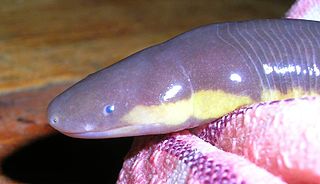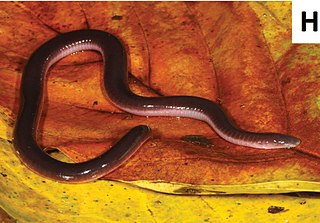
Caecilians are a group of limbless, vermiform (worm-shaped) or serpentine (snake-shaped) amphibians with small or sometimes nonexistent eyes. They mostly live hidden in soil or in streambeds, and this cryptic lifestyle renders caecilians among the least familiar amphibians. Modern caecilians live in the tropics of South and Central America, Africa, and southern Asia. Caecilians feed on small subterranean creatures such as earthworms. The body is cylindrical and often darkly coloured, and the skull is bullet-shaped and strongly built. Caecilian heads have several unique adaptations, including fused cranial and jaw bones, a two-part system of jaw muscles, and a chemosensory tentacle in front of the eye. The skin is slimy and bears ringlike markings or grooves and may contain scales.

The Ichthyophiidae are the family of Asiatic tailed caecilians or fish caecilians found in South and Southeast Asia as well as southernmost China.

Uraeotyphlus is a genus of caecilians in the family Ichthyophiidae. There are seven species in this genus, all of which are endemic to the Western Ghats of southwestern India. Previously, the genus has also been placed in its own monotypic family Uraeotyphlidae.

The Scolecomorphidae are a family of caecilians also known as tropical caecilians, buried-eyed caecilians, or African caecilians. They are found in Cameroon in West Africa, and Malawi and Tanzania in East Africa. Caecilians are legless amphibians which superficially resemble worms or snakes.

Ichthyophis garoensis, the Garo Hills caecilian, is a species of caecilian found in Assam and Meghalaya in north-eastern India. The Husain's caecilian Ichthyophis husaini was until 2016 considered a separate species. It is a subterranean caecilian that lives in the moist leaf-litter of tropical forests. It is typically found close to streams and other waterbodies.

Uraeotyphlus interruptus, also known as the Chengalam caecilian, is a species of caecilian in the family Ichthyophiidae. It is endemic to the Western Ghats in southern India and is only known from its type locality, Chengalam village in Kerala.
Uraeotyphlus malabaricus is a species of caecilian in the family Ichthyophiidae. It is endemic to the Western Ghats of India and is known from its type locality, "Malabar" in Kerala, and from the Nilgiri mountains in Tamil Nadu. It is known with several common names: Malabar tailed caecilian, Nilgiris caecilian, Malabar caecilian, and white-lipped caecilian.

Uraeotyphlus oxyurus, also known as the red caecilian, sharp-nosed caecilian, dark-brown caecilian, pale-throated caecilian, or harp-tailed caecilian, is a species of caecilian in the family Ichthyophiidae. It is endemic to the Western Ghats in Kerala and Tamil Nadu, southern India.
Chikila fulleri, also known as the Kuttal caecilian, Fuller's caecilian, and Fuller's chikila, is a species of caecilian from South Asia. In 2012 it was reassigned to a newly erected family, Chikilidae.
Gegeneophis ramaswamii, common names Tenmalai caecilian, Tenmalai blind caecilian, Ramaswami's caecilian, and forest caecilian is a species of caecilian. It is endemic to the southern portion of the Western Ghats, India, and is recorded from Kerala and Tamil Nadu. The specific name ramaswamii honours L. S. Ramaswami, an Indian herpetologist.
Indotyphlus maharashtraensis is a species of caecilians described in 2004 by scientists of Bombay Natural History Society and the Natural History Museum, London. It is only the second species of Indotyphlus known to science, and only known from its type locality near Humbarli village, Satara District, in the Western Ghats of Maharashtra, India. Common names Humbarli caecilian, Maharashtra caecilian, and Konkan tail-less caecilian have been coined for it.

The Western Ghats in India are home to several species of caecilians (Gymnophiona). Caecilians are legless, burrowing amphibians which mostly live in leaf litter, loose soil, under rocks and decaying logs. They are also found in agricultural fields and only surface during the monsoon. The body is elongated and smooth with a slimy skin. The smaller caecilians superficially resemble earthworms while the larger ones are often mistaken for snakes. However, they can be told apart from earthworms by the presence of eyes, teeth and skeleton and from snakes by the lack of scales on skin. The eyes in caecilians are not well developed which is most likely to be because of their burrowing life style. They are considered as rare which is apparently due to their subterranean habits. To see them one has to search carefully and be at the right place and at the right time. There are few places where they are common, but, at least one species was reported to be abundant in agricultural fields in Kerala. The larger caecilians can resemble snakes, but their skin is smooth, not scaly.
Herpele multiplicata is a species of caecilian in the family Herpelidae. It is endemic to Cameroon. It is only known from its holotype, which is now lost. The only available information is the brief species description published in 1912 by Fritz Nieden. Common name Victoria caecilian has been coined for it.

Herpele squalostoma is a species of caecilian in the family Herpelidae. It is also known by the common name Congo caecilian. It is found in Central and extreme easternmost West Africa.
Mimosiphonops reinhardti is a species of caecilian in the family Siphonopidae. It is endemic to Brazil. It is only known from the holotype collected from "Brasilia" in 1878, probably somewhere in eastern Brazil. The specific name reinhardti honors Johannes Theodor Reinhardt, Danish zoologist and herpetologist who collected the holotype. Common name Reinhardt's caecilian has been proposed for this species.
Mimosiphonops vermiculatus is a species of caecilian in the family Siphonopidae. It is endemic to Brazil and known with certainty only from its type locality, Teresópolis in the Rio de Janeiro state. Common name worm-patterned caecilian has been proposed for this species.
Ichthyophis bernisi, the Indonesia caecilian or Indonesian caecilian, is a species of amphibian in the family Ichthyophiidae. It is endemic to Java (Indonesia). It is only known from the holotype collected from an unspecified location on Java before 1975. The specific name bernisi honors Francisco Bernis Madrazo, a Spanish ornithologist.

The Koh Tao Island caecilian is a species of amphibian in the family Ichthyophiidae found in Cambodia, Laos, Myanmar, Thailand, and Vietnam. Also known as the Ichthyophis bannanicus, the Banna caecilian, it is also found in southern China.
Ichthyophis khumhzi, the Khumhzi striped ichthyophis, is a species of caecilian found in India. It has narrow and irregular lateral yellow stripes. It can attain lengths larger than 400 mm (16 in). Its head is V-shaped while short; the animal shows scales as far anterior as its collars. The species is named after Khumhzi village, where the specimens were first collected.

Ichthyophis kodaguensis, also known as the Kodagu striped Ichthyophis, is a species of caecilian in the family Ichthyophiidae. It is endemic to the southern Western Ghats, India. All confirmed records are from southern Karnataka state, although it is also reported from adjacent Kerala.











